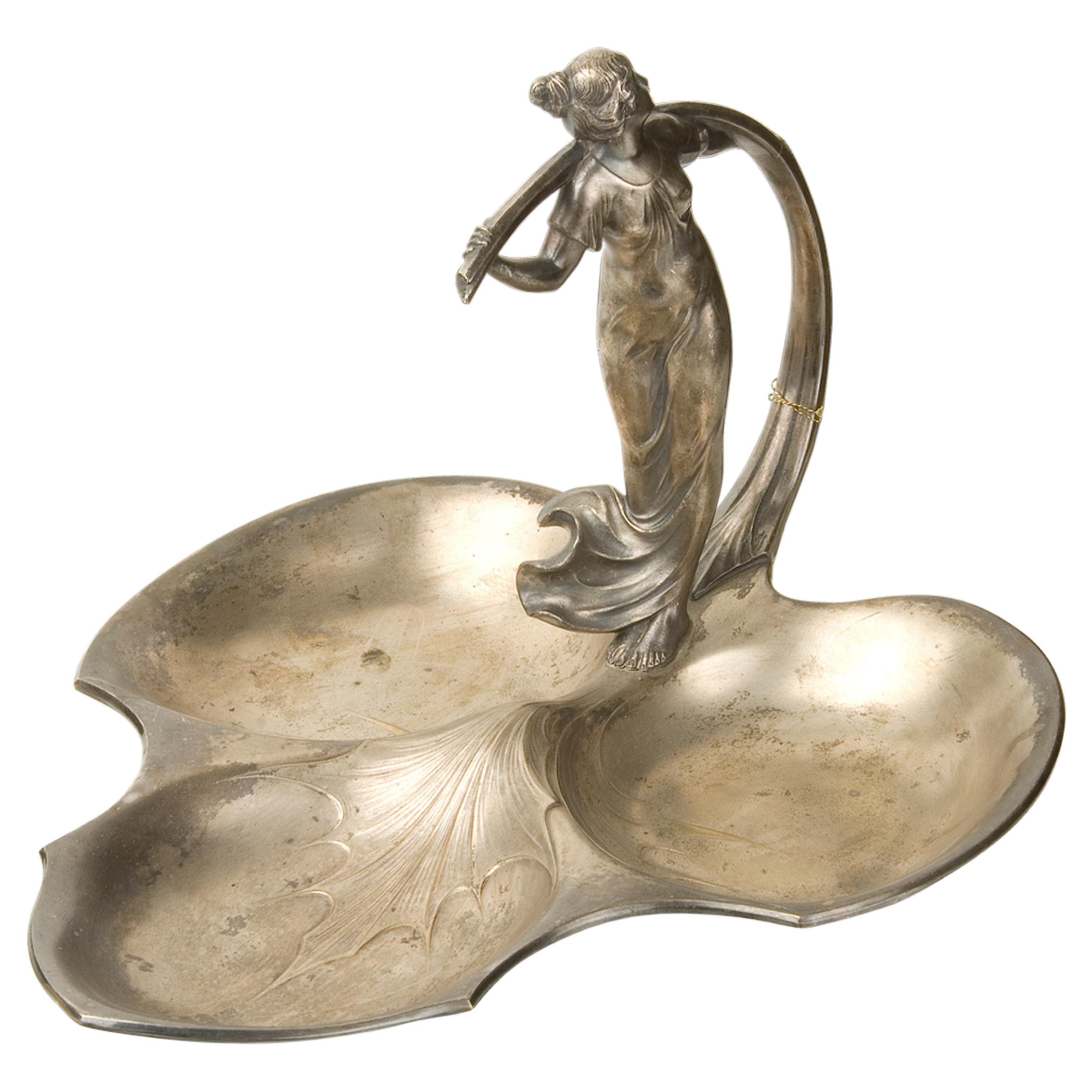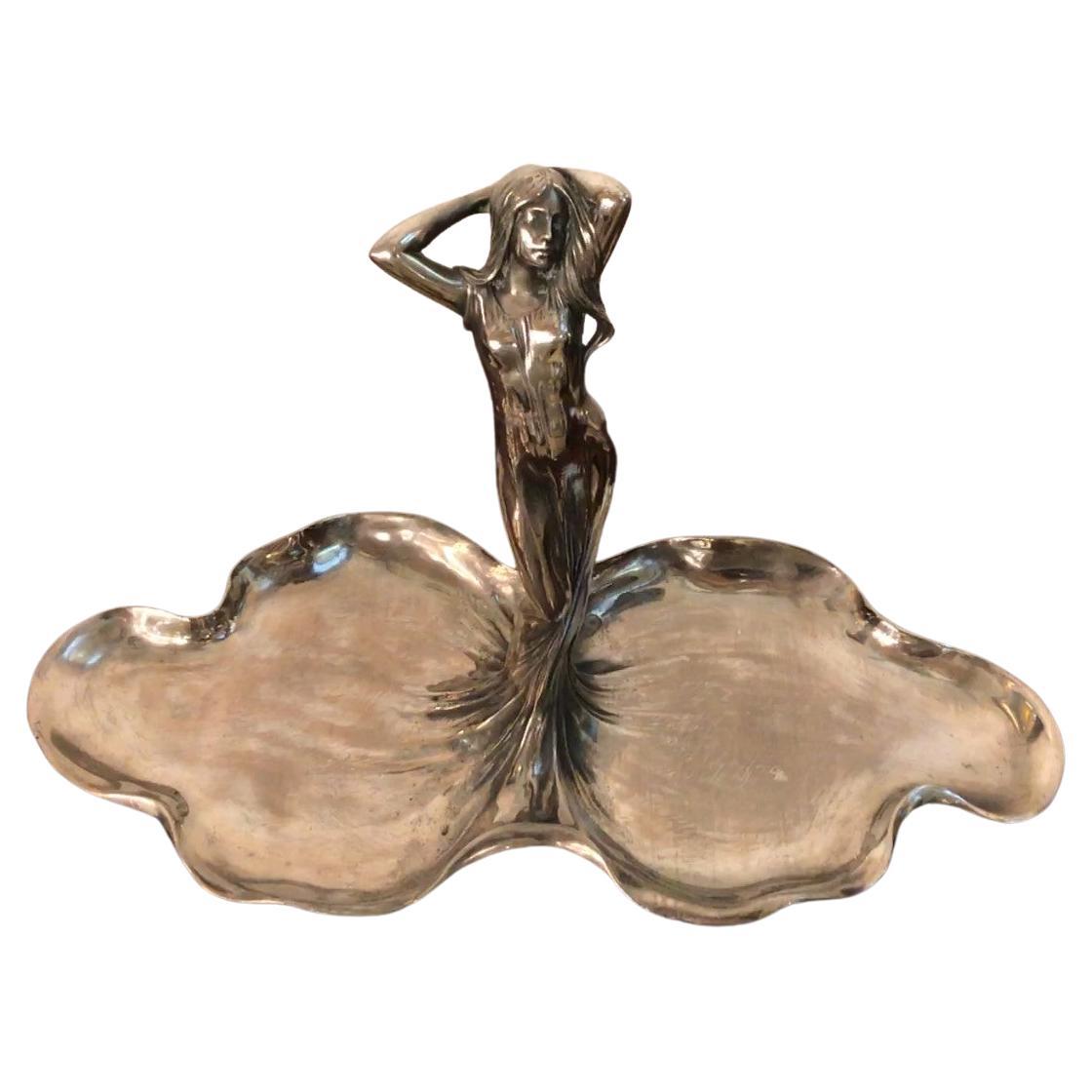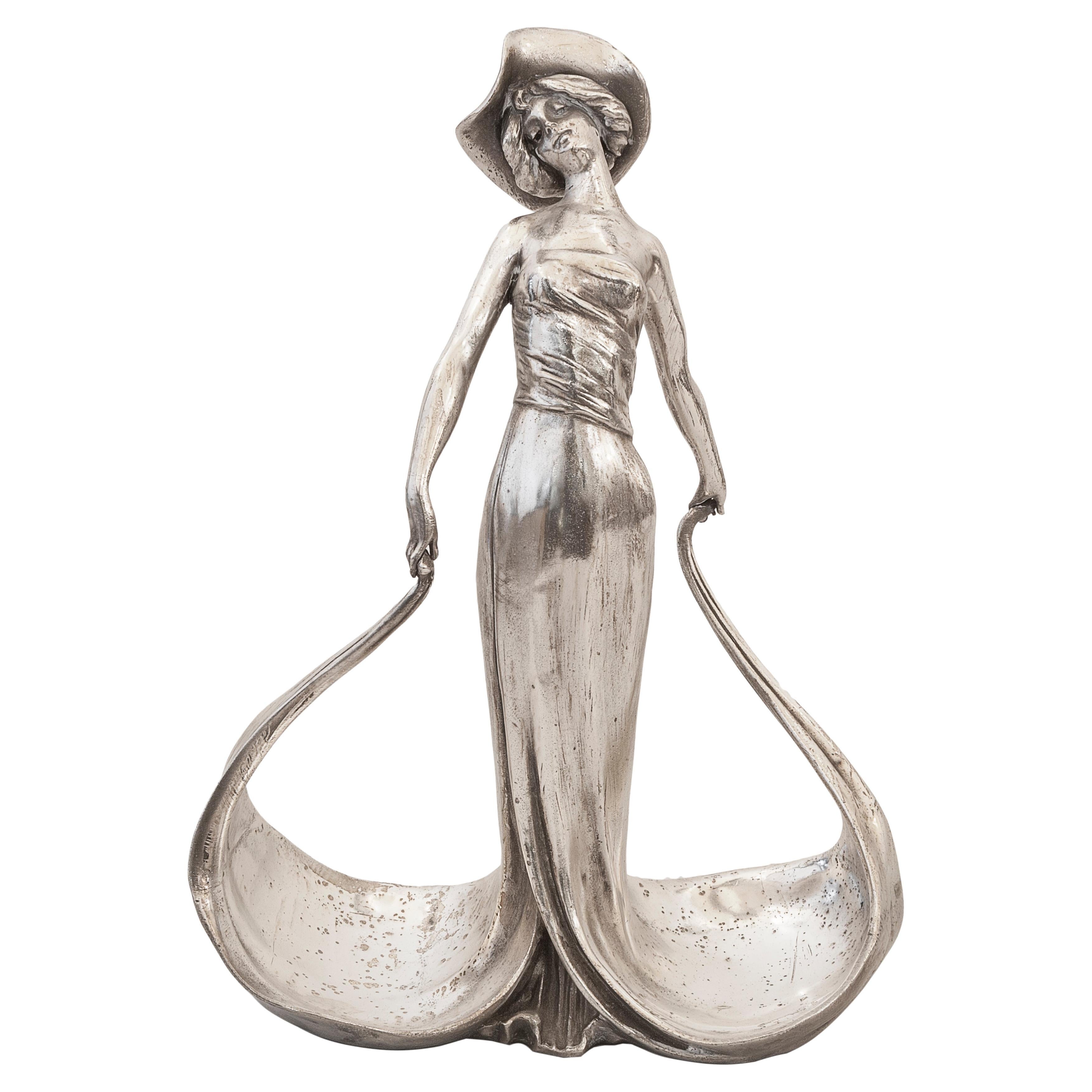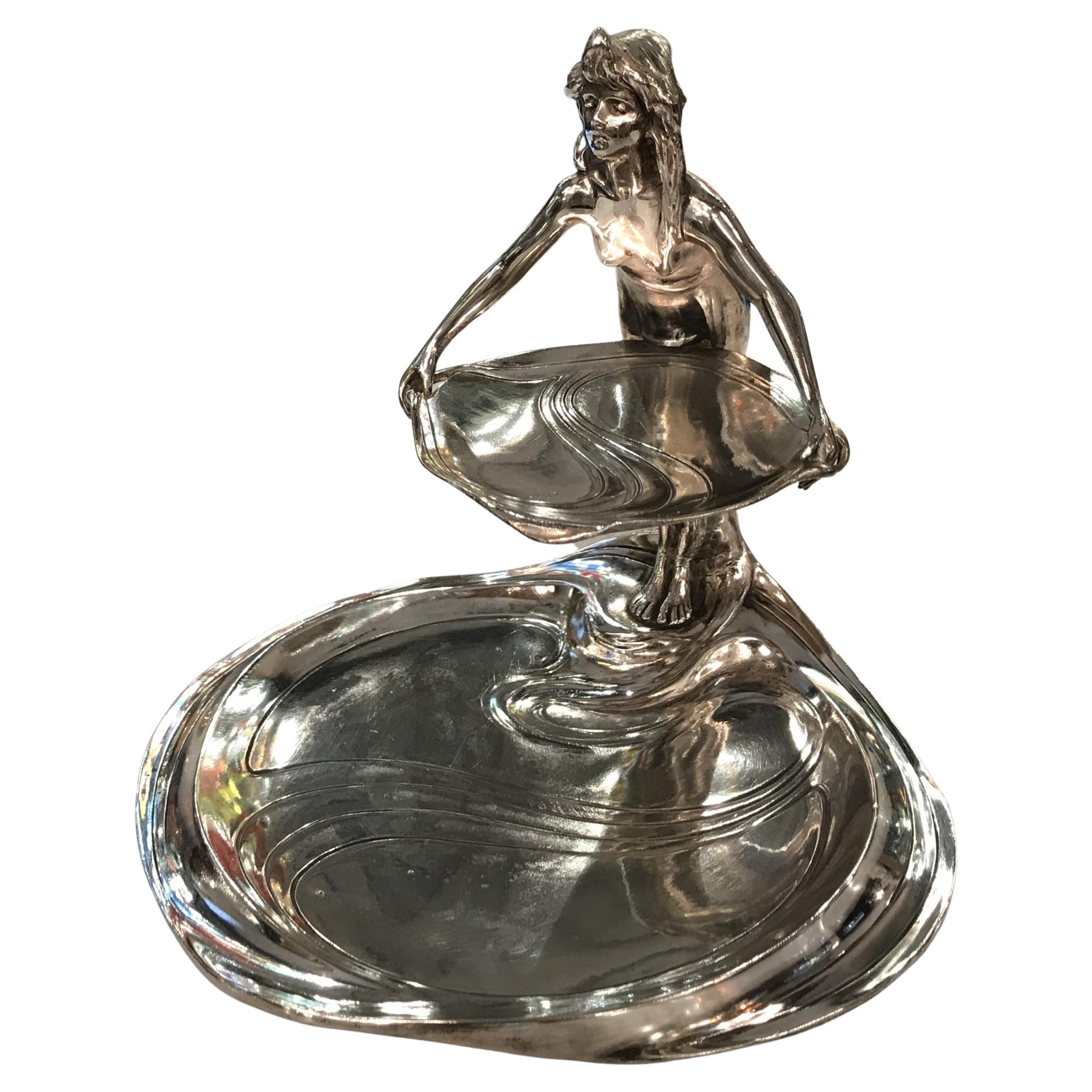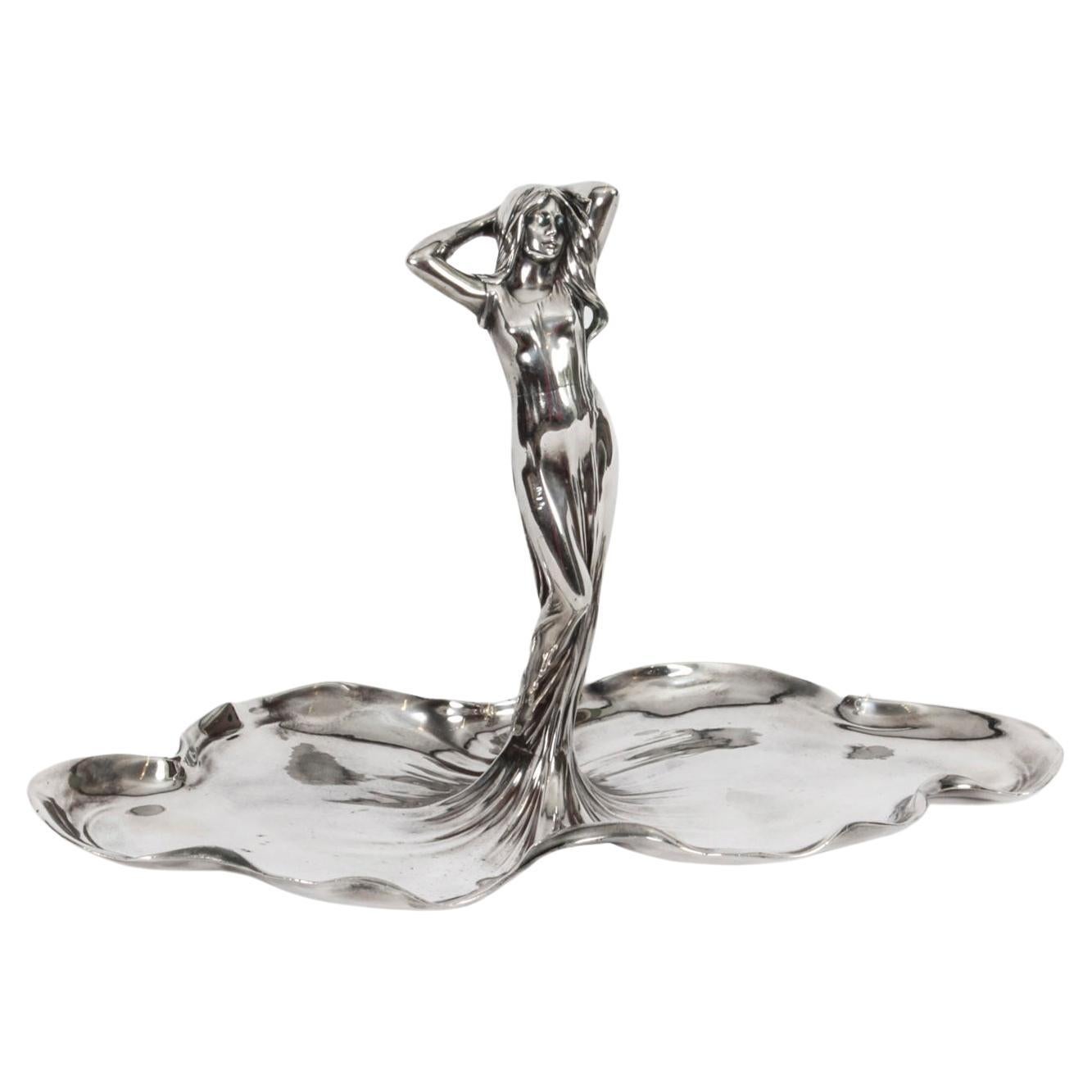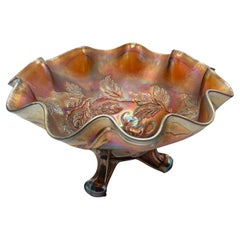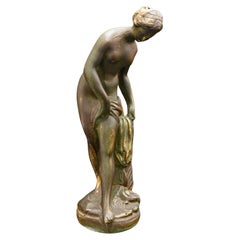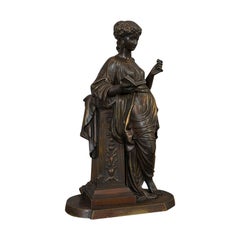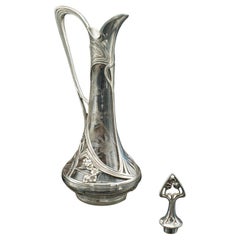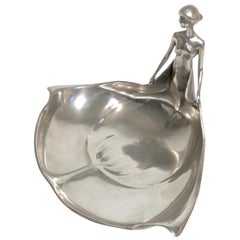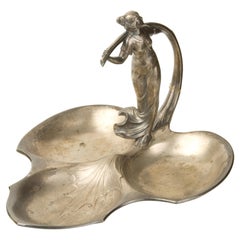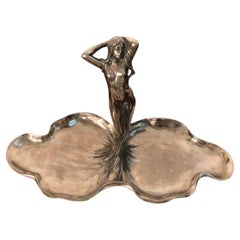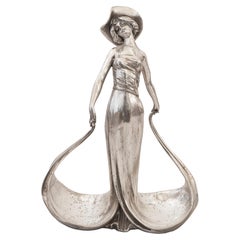Items Similar to Antique Art Nouveau Centrepiece Figure, German Card Tray, Bonbon Dish, Victorian
Want more images or videos?
Request additional images or videos from the seller
1 of 13
Antique Art Nouveau Centrepiece Figure, German Card Tray, Bonbon Dish, Victorian
$2,286.23
£1,661
€1,946.96
CA$3,121.13
A$3,472.13
CHF 1,820.14
MX$42,428.63
NOK 23,177.16
SEK 21,818.09
DKK 14,533.32
Shipping
Retrieving quote...The 1stDibs Promise:
Authenticity Guarantee,
Money-Back Guarantee,
24-Hour Cancellation
About the Item
This is an antique Art Nouveau centrepiece. A German, cast alloy figural card tray or decorative bonbon dish, dating to the late Victorian period, circa 1900.
Captivating Art Nouveau female form, with flowing lines and superb reflectivity
Displays a desirable aged patina and in very good order
Cast alloy form polished to an exceptional silver tonality
Stood in a sensual pose, the figure's dress flows outwards into a flared dish
WMF maker's mark to base for the Württembergische Metallwarenfabrik
AS mark to base signifies the 'antique silver' finish to the EP - electro plating
This is a striking antique Art Nouveau centrepiece, with a beautiful tonality and appealing visual form. Delivered ready to display.
Dimensions:
Max Width: 35cm (13.75'')
Max Depth: 16.5cm (6.5'')
Max Height: 22cm (8.75'')
- Dimensions:Height: 8.67 in (22 cm)Width: 13.78 in (35 cm)Depth: 6.5 in (16.5 cm)
- Style:Art Nouveau (Of the Period)
- Materials and Techniques:
- Place of Origin:
- Period:
- Date of Manufacture:circa 1900
- Condition:Wear consistent with age and use. Presented in very good antique condition.
- Seller Location:Hele, Devon, GB
- Reference Number:Seller: 245321stDibs: LU2645340901302
About the Seller
5.0
Platinum Seller
Premium sellers with a 4.7+ rating and 24-hour response times
Established in 2005
1stDibs seller since 2017
1,028 sales on 1stDibs
Typical response time: 1 hour
- ShippingRetrieving quote...Shipping from: Hele, Devon, United Kingdom
- Return Policy
Authenticity Guarantee
In the unlikely event there’s an issue with an item’s authenticity, contact us within 1 year for a full refund. DetailsMoney-Back Guarantee
If your item is not as described, is damaged in transit, or does not arrive, contact us within 7 days for a full refund. Details24-Hour Cancellation
You have a 24-hour grace period in which to reconsider your purchase, with no questions asked.Vetted Professional Sellers
Our world-class sellers must adhere to strict standards for service and quality, maintaining the integrity of our listings.Price-Match Guarantee
If you find that a seller listed the same item for a lower price elsewhere, we’ll match it.Trusted Global Delivery
Our best-in-class carrier network provides specialized shipping options worldwide, including custom delivery.More From This Seller
View AllVintage Flared Carnival Dish, English, Lustre Glass, Bonbon Bowl, Art Deco, 1930
Located in Hele, Devon, GB
This is a vintage flared Carnival dish. An English, lustre glass decorative bonbon bowl, dating to the Art Deco period, circa 1930.
Striking lustre dance...
Category
Early 20th Century British Art Deco Decorative Bowls
Materials
Glass
Antique Female Figure, French, Plaster Statuette, Ornament, Victorian, Classical
Located in Hele, Devon, GB
This is an antique female figure. A French, plaster statuette, dating to the late Victorian period, circa 1900.
Sensual female study with an appealing bronzed finish
Displays a des...
Category
Antique Late 19th Century French Late Victorian Figurative Sculptures
Materials
Plaster
Antique Bronze Figure, French, Female, Art Nouveau, After Moreau, circa 1920
Located in Hele, Devon, GB
This is an antique bronze figure. A French, female statue of Art Nouveau taste in the manner of Hippolyte François Moreau, dating to the early 20th century, circa 1920.
Sculpture ...
Category
Early 20th Century French Figurative Sculptures
Materials
Bronze
Antique Art Nouveau Decanter, German, Decorative, Spirit Ewer, Victorian, C.1900
Located in Hele, Devon, GB
This is an antique Art Nouveau decanter. A German, cast alloy decorative spirit ewer, dating to the late Victorian period, circa 1900.
Fascinating Art Nouveau craftsmanship, presen...
Category
Antique Late 19th Century German Late Victorian Pitchers
Materials
Metal
Antique Art Nouveau Ink Well, French, Pewter, Decorative Pen Tray, Victorian
Located in Hele, Devon, GB
This is an antique Art Nouveau ink well. A French, pewter decorative pen tray, dating to the late Victorian period, circa 1900.
Wonderful example fro...
Category
Antique Late 19th Century French Late Victorian Inkwells
Materials
Pewter
Antique Art Nouveau Planter, French, Windowsill, Outdoor, Jardiniere, Victorian
Located in Hele, Devon, GB
This is an antique Art Nouveau planter. A French, cast iron windowsill or outdoor jardiniere, dating to the late Victorian period, circa 1900.
Excellent tonality and appealing Art Nouveau taste
Displays a desirable aged patina and in good order
Striking silvered graphite finish to the cast iron form
Foliate motif accentuates the distinctive fascia
Generously sized interior ideal for a well-lit windowsill or garden setting
This is a versatile antique Art Nouveau planter, useful for indoor or outdoor planting...
Category
Antique Late 19th Century French Art Nouveau Planters and Jardinieres
Materials
Iron
You May Also Like
Centerplace, German, Jugendstil, Art Nouveau, Liberty, 1898, Sign: Orivit 2638
By Orivit
Located in Ciudad Autónoma Buenos Aires, C
Centerplace, orivit, German
Year: 1898
Firms:
Orivit 2638 = Signature name with its numbering.
Casa Costa = Name of the house that sold it in Argentina.
Orivit
The company was...
Category
Antique 1890s German Art Nouveau Centerpieces
Materials
Metal
Art Nouveau or Modernist Tray, Metal
Located in Madrid, ES
Modernist tray. Metal
Tray formed by a base with three holes worked like a leaf. Its upturned petiole supports a female figure dressed in a tunic flutt...
Category
20th Century European Art Nouveau More Desk Accessories
Materials
Metal
Sweet and Fruit Dishes, Jugendstil, Art Nouveau, Liberty, 1900, Sign WMF, German
By WMF Württembergische Metallwarenfabrik
Located in Ciudad Autónoma Buenos Aires, C
Double fruit or Sweet dish, Centerplace, WMF, German
Firms:
Page: 342 in the Book – Art Nouveau Domestic Metalwork from WMF Wurttembergische Metallwarenfabrik: The English Catalogue...
Category
Antique Early 1900s German Art Nouveau Centerpieces
Materials
Metal
Centerplace, France, Jugendstil, Art Nouveau, Liberty, 1900, Sign: L. Alliot
Located in Ciudad Autónoma Buenos Aires, C
Centerplace,
Year: 1900
Firms:
L. Alliot
We have specialized in the sale of Art Deco and Art Nouveau and Vintage styles since 1982. If you have any questions we are at your disp...
Category
Antique Early 1900s French Art Nouveau Centerpieces
Materials
Metal
Visiting card Tray, German, Jugendstil, Art Nouveau, Liberty, 1900, WMF
By WMF Württembergische Metallwarenfabrik
Located in Ciudad Autónoma Buenos Aires, C
Visiting card Tray, WMF, German
WMF (Wurttembergische Metallwarenfabrik)
Electro- Wurtemberg Plate Company in Geislingen, Germany, internation...
Category
Antique Early 1900s German Art Nouveau Centerpieces
Materials
Metal
Antique WMF Silver Plated Sweets / Visiting Card / Key/ Tray Early 20th Century
Located in London, GB
This is a beautiful WMF Art Nouveau silver plated visiting card tray Circa 1900 in date.
Depicting a female figure in a long, flowing diaphanous dress, the train forming the double sided tray, with the impressed maker's mark and stamped '169' to underside.
This exquisite casket could house anything from trinkets, keys, sweets to jewellery.
Whatever you choose to use this item for you are sure to do it in style.
Condition:
In excellent condition with no dings, dents or signs of repair. Please see photos for confirmation.
Dimensions in cm:
Height 22 x Width 34.5 x Depth 16.5
Dimensions in inches:
Height 9 inches x Width 1 foot, 2 inches x Depth 6 inches
WMF
In 1853, Daniel Straub, a miller from Geislingen, joined forces with the Schweizer Brothers to form the "Metallwarenfabrik Straub & Schweizer" in Geislingen.
This was the second company to be founded by Straub - previously in 1850, from the nucleus of a small repair workshop, which he had set up to work on the construction of Geislingen's famous railway incline, he had founded Maschinenfabrik Geislingen. This company was involved mainly in manufacturing mill turbines and traded throughout Europe.
As early as 1862, the young company distinguished itself by winning a gold medal at the World Exhibition in London. In 1866, following the departure of the brothers Louis and Friedrich Schweizer, the company was renamed Straub & Sohn" (Straub & Son). The company showroom, built in 1868 in Berlin, gradually evolved to become the company's first retail outlet. Three years later, the company was already employing 60 workers. By 1880, the number of employees had grown to approximately 200 and the company was already producing 960 different items.
1880 saw the merger between Straub & Sohn and "Ritter & Co.", Esslingen, to form a public limited company under the name of Wurttembergische Metallwarenfabrik. At the time of the merger, Ritter & Co.'s Esslingen factory was already using the electroplating method of silver plating and had the more modern production facilities at its disposal. Straub's company, on the other hand, was the more profitable of the two.
1892 saw the development of a special technique for silver plating cutlery, whereby the silver is distributed in a way that, at the points of the cutlery most exposed to wear and tear, the coating is twice as thick as elsewhere. This process was patented and is still in use today. Known nowadays as 'Perfect Hard Silver plating' the technique remains exclusive to WMF.
Under Carl Hugele the company gained international standing. At the turn of the century the factory in Geislingen employed 3,000 workers. By 1910, this number had already grown to 4,000, making WMF the largest company in Wurttemberg at this time. Sales catalogues were printed in twelve languages. Subsidiary companies in London, Warsaw and Vienna opened up export markets.
Under the direction of Albert Mayer the WMF studio was influenced by the art nouveau style. The product range was modernized and considerably extended. In 1905 WMF acquired a majority holding of the Cologne company Orivit AG, which manufactured products from "Orivit", a tin alloy.
As of 1925, products created by the Contemporary Decorative Products Department (NKA) made their debut on the market. This department was set up under the direction of Hugo Debach in order to establish the name of WMF amongst consumers interested in art and design. This department was responsible for producing the special "Ikora" finish, which has earned an important place in the annals of art history. The "Ikora" brand name referred to a specific method of treating the surface of the metal, by which layers of coating were applied in a partly chemical and partly heat induced process. A host of newly developed hand-finishing techniques enhanced the possibilities for adding decorative flourishes to the products. Despite being mass produced, every item looked as if it had been individually crafted.
At the end of the war the company had lost its foreign assets, associated factories...
Category
Antique Early 1900s German Art Nouveau Sheffield and Silverplate
Materials
Silver Plate
More Ways To Browse
Figural Art Nouveau
German Victorian Furniture
Antique Bowls Germany
Metal Dress Forms
Antique Art Nouveau Trays
German Metal Trays
Art Nouveau Dish
Art Nouveau Centrepiece
Wmf Figural
Antique Metal Dress Form
Wmf Tray
Silver Card Tray
Antique German Silver Basket
Art Nouveau Card Tray
Wmf Art Nouveau Tray
Victorian Metal Basket
Bonbon Dish
Canton Basket

